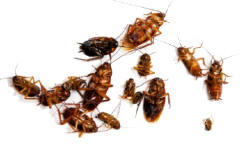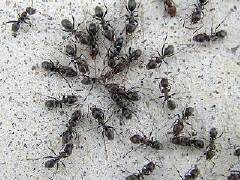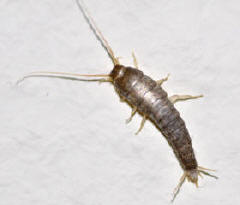We offer professional pest management treatments for the following
pests and more.
|
Termites |
Rats |
Mice |
Cockroaches |
Ants |
Spiders |
|
Silverfish |
Wasps |
Fleas |
Bed Bugs |
Carpet Beetles |
Bees |
More pest information...
Termite - pest
control.
.jpg) While
termites are commonly known, especially in Australia, as "white
ants," they are only distantly related to the ants. Many insects are
confused with termites, especially ants. Termites are sometimes
referred to as ?white ants? because of their pale appearance.
Regular inspections are the most important part of controlling
termites before they cause any damage. Termites (Isoptera) are an
ancient order of insects whose origins date back more than 100
million years to the Cretaceous period. Although they are commonly
called ?white ants?, the resemblance to ants is superficial and they
are more closely related to cockroaches (Blattodea). Termites are
social insects, working and living together in groups (colonies).
Each colony contains several types (castes) which differ in body
shape and behaviour, and each caste is specialised to perform
different tasks. Termites have three principal castes are recognised:
workers, soldiers and reproductives (the primary king and queen and
sometimes supplementary reproductives). Australia is a big and
varied country, from cooler temperate climates to wet tropical ones.
Such variation is important to remember when considering termite
control methods. Should one particular method work well for one
house, it may not prove appropriate for a second. So when
considering a termite management plan make sure it is the most
effective method of treatment to protect your home. While
termites are commonly known, especially in Australia, as "white
ants," they are only distantly related to the ants. Many insects are
confused with termites, especially ants. Termites are sometimes
referred to as ?white ants? because of their pale appearance.
Regular inspections are the most important part of controlling
termites before they cause any damage. Termites (Isoptera) are an
ancient order of insects whose origins date back more than 100
million years to the Cretaceous period. Although they are commonly
called ?white ants?, the resemblance to ants is superficial and they
are more closely related to cockroaches (Blattodea). Termites are
social insects, working and living together in groups (colonies).
Each colony contains several types (castes) which differ in body
shape and behaviour, and each caste is specialised to perform
different tasks. Termites have three principal castes are recognised:
workers, soldiers and reproductives (the primary king and queen and
sometimes supplementary reproductives). Australia is a big and
varied country, from cooler temperate climates to wet tropical ones.
Such variation is important to remember when considering termite
control methods. Should one particular method work well for one
house, it may not prove appropriate for a second. So when
considering a termite management plan make sure it is the most
effective method of treatment to protect your home.
Rodents - Rats and Mice - pest control.
 Where
there are humans there are rats and mice. Rodents have successfully
adapted to survive and thrive around our homes, our place of
business and our pets. We provide food and shelter for rats and mice
to breed prolifically. Where
there are humans there are rats and mice. Rodents have successfully
adapted to survive and thrive around our homes, our place of
business and our pets. We provide food and shelter for rats and mice
to breed prolifically.
There
is a lot you can do to help prevent rats and mice from entering your
home by physically proofing entry points to the home. Trimming back
trees and shrubs to prevent easy access and do not store personal
belongings around the perimeter of your home because you may just
find some uninvited rodents when you move them next.
If
you have a rat or mouse problem you need to consider using a baiting
program. A baiting program is the most cost effective way to quickly
and easily get rid of rats and mice in your home without mess or
fuss as long as you use the right bait and it is strategically
placed away from children and pets.
Cockroaches
- pest control.
 Like the household fly, the
cockroach will eat virtually anything ranging from food spills on a
kitchen floor to faecal matter. Ingested bacteria can survive in the
cockroaches digestive system, sometimes for months or even years, and are
passed in its droppings. Cockroaches will vomit and defaecate on food and
it is thought that disease may be transmitted to humans when humans eat
food contaminated by cockroaches. Recent research shows that the cockroach
can cause strong allergic reactions in some people. A female cockroach
lays between 10 and 40 eggs at a time. On average, the female can lay
around 30 batches of eggs in her lifetime. The hatched young look the same
as adult cockroaches, but smaller and without wings. Depending on the
conditions and type, a cockroach can live for up to 12 months. These
insects are cold-blooded and thrive in warm, humid conditions. The first
step to take before any pest control treatment is carried out is to
thoroughly clean all areas that could be harbouring cockroaches, this will
also ensure the pest control treatment carried out will be most effective
and longer lasting. There are many ways to treat cockroaches which will
depend on the situation and type of cockroach which makes it very
important to identify the species of cockroach before the treatment is
implemented. Like the household fly, the
cockroach will eat virtually anything ranging from food spills on a
kitchen floor to faecal matter. Ingested bacteria can survive in the
cockroaches digestive system, sometimes for months or even years, and are
passed in its droppings. Cockroaches will vomit and defaecate on food and
it is thought that disease may be transmitted to humans when humans eat
food contaminated by cockroaches. Recent research shows that the cockroach
can cause strong allergic reactions in some people. A female cockroach
lays between 10 and 40 eggs at a time. On average, the female can lay
around 30 batches of eggs in her lifetime. The hatched young look the same
as adult cockroaches, but smaller and without wings. Depending on the
conditions and type, a cockroach can live for up to 12 months. These
insects are cold-blooded and thrive in warm, humid conditions. The first
step to take before any pest control treatment is carried out is to
thoroughly clean all areas that could be harbouring cockroaches, this will
also ensure the pest control treatment carried out will be most effective
and longer lasting. There are many ways to treat cockroaches which will
depend on the situation and type of cockroach which makes it very
important to identify the species of cockroach before the treatment is
implemented.
Spiders - pest
control
.jpg) There are more than 2000 different spiders in
Australia. Only a few of them are dangerous: these include the red-back
spider, the Sydney funnel-web spider and white-tailed spiders. Other
spiders such as the wolf spiders and the large bird-eating spider look
fierce but are not usually a danger to people. Spiders live almost
everywhere, even in the Arctic and on mountain tops. They live where they
can find food. They live on plants, near swamps, underground, in caves and
in deserts. One kind of spider spends most of its life under water. Some
spiders live in our houses, in sheds or other buildings. Others live on
the outside walls of buildings or in the corners of windows. All spiders
spin silk. Some make webs with the silk to catch insects for food. Some
kinds of spiders do not make webs. They catch food by jumping on it. All
spiders have hollow fangs and most use them to inject poison into their
prey when they capture it. Spiders eat insects but some spiders eat
tadpoles, small frogs and fish, and mice. Spiders sometimes eat each
other. Female redback spiders often eat the smaller, male redback spiders.
This is why it is very important to treat the house and surrounding yard
including outbuildings, garden areas and fence lines because you may have
a variety of spiders you are trying to treat in and around your home. There are more than 2000 different spiders in
Australia. Only a few of them are dangerous: these include the red-back
spider, the Sydney funnel-web spider and white-tailed spiders. Other
spiders such as the wolf spiders and the large bird-eating spider look
fierce but are not usually a danger to people. Spiders live almost
everywhere, even in the Arctic and on mountain tops. They live where they
can find food. They live on plants, near swamps, underground, in caves and
in deserts. One kind of spider spends most of its life under water. Some
spiders live in our houses, in sheds or other buildings. Others live on
the outside walls of buildings or in the corners of windows. All spiders
spin silk. Some make webs with the silk to catch insects for food. Some
kinds of spiders do not make webs. They catch food by jumping on it. All
spiders have hollow fangs and most use them to inject poison into their
prey when they capture it. Spiders eat insects but some spiders eat
tadpoles, small frogs and fish, and mice. Spiders sometimes eat each
other. Female redback spiders often eat the smaller, male redback spiders.
This is why it is very important to treat the house and surrounding yard
including outbuildings, garden areas and fence lines because you may have
a variety of spiders you are trying to treat in and around your home.
Ants - pest control
 Ants are social insects which form small to
large colonies. A typical colony contains an egg-laying queen and many
adult workers together with their brood (eggs, larvae and pupae). Workers
are by far the most numerous individuals in the nest. They are responsible
for nest construction, maintenance, foraging, tending the brood and queen,
and nest defence. The workers are the most commonly seen caste, especially
as they forage on the surface of the ground or when they are disturbed
under rocks or other objects. However, in most species not all workers
forage outside of the nest. Ants show a strong division of labour, where
different workers perform different tasks within the nest and in some
cases the specific tasks undertaken will depend on the age of the ant. The
majority of ants are general predators or scavengers, feeding on a wide
range of prey including other arthropods and seeds. Adult ants feed
exclusively on liquid foods. They collect these liquids from their prey or
while tending Hemiptera and other insects. Solid prey, that which is most
often seen being carried by workers, is generally intended as food for
larvae. Adults which remain in the nest, including the queen, receive much
or all of their food directly from returning foragers in a process called
trophallaxis. During foraging, workers collect fluids which are stored in
the upper part of their digestive system (the crop). Upon returning to the
nest, these workers regurgitate a portion of this stored fluid and pass it
on to other workers. This is why ant baits are highly effective in certain
situations where the ants take the strategically placed bait and transfer
the bait throughout the colony. The only drawback with baiting is it does
not usually give you an instant result but it can quite possibly give you
a much better long term result instead of continuous spraying of
chemicals. Ants are social insects which form small to
large colonies. A typical colony contains an egg-laying queen and many
adult workers together with their brood (eggs, larvae and pupae). Workers
are by far the most numerous individuals in the nest. They are responsible
for nest construction, maintenance, foraging, tending the brood and queen,
and nest defence. The workers are the most commonly seen caste, especially
as they forage on the surface of the ground or when they are disturbed
under rocks or other objects. However, in most species not all workers
forage outside of the nest. Ants show a strong division of labour, where
different workers perform different tasks within the nest and in some
cases the specific tasks undertaken will depend on the age of the ant. The
majority of ants are general predators or scavengers, feeding on a wide
range of prey including other arthropods and seeds. Adult ants feed
exclusively on liquid foods. They collect these liquids from their prey or
while tending Hemiptera and other insects. Solid prey, that which is most
often seen being carried by workers, is generally intended as food for
larvae. Adults which remain in the nest, including the queen, receive much
or all of their food directly from returning foragers in a process called
trophallaxis. During foraging, workers collect fluids which are stored in
the upper part of their digestive system (the crop). Upon returning to the
nest, these workers regurgitate a portion of this stored fluid and pass it
on to other workers. This is why ant baits are highly effective in certain
situations where the ants take the strategically placed bait and transfer
the bait throughout the colony. The only drawback with baiting is it does
not usually give you an instant result but it can quite possibly give you
a much better long term result instead of continuous spraying of
chemicals.
Silverfish - pest control
 Silverfish are small, fast, wingless insects
with a steel grey colour that gives them their name, often called carpet
sharks They are long and flat with bristly protrusions at their abdomen.
These fast running insects have become common inhabitants of our homes and
are often found in dark sheltered areas. Silverfish are usually less than
20 millimetres in length and silvery-grey in colour. They are often found
in relatively undisturbed areas (eg bookcases, storage rooms), where they
may damage paper, fabrics and other materials. Female silverfish lay eggs
singly or in small batches, and these usually hatch in 2 - 8 weeks. The
hatchlings closely resemble the adult form and undergo a number of moults.
Usually, sexual maturity is attained after about 3 - 24 months. Silverfish
continue to moult periodically throughout their adult life, which may be
as long as four years. Silverfish are agile, fast running, nocturnal
insects that generally shun light. They are usually found in dark,
undisturbed places but may range fairly widely throughout a given
dwelling. Their inability to climb smooth surfaces often results in their
being trapped in bathtubs and basins. Silverfish usually live and develop
close to their food source in damp, cool places, though they have the
ability to live without food for several months. This pest is one of the
most difficult to totally eliminate. The more food available, the more
silverfish thrive, so professional treatment is advised with high level of
house keeping. Silverfish are small, fast, wingless insects
with a steel grey colour that gives them their name, often called carpet
sharks They are long and flat with bristly protrusions at their abdomen.
These fast running insects have become common inhabitants of our homes and
are often found in dark sheltered areas. Silverfish are usually less than
20 millimetres in length and silvery-grey in colour. They are often found
in relatively undisturbed areas (eg bookcases, storage rooms), where they
may damage paper, fabrics and other materials. Female silverfish lay eggs
singly or in small batches, and these usually hatch in 2 - 8 weeks. The
hatchlings closely resemble the adult form and undergo a number of moults.
Usually, sexual maturity is attained after about 3 - 24 months. Silverfish
continue to moult periodically throughout their adult life, which may be
as long as four years. Silverfish are agile, fast running, nocturnal
insects that generally shun light. They are usually found in dark,
undisturbed places but may range fairly widely throughout a given
dwelling. Their inability to climb smooth surfaces often results in their
being trapped in bathtubs and basins. Silverfish usually live and develop
close to their food source in damp, cool places, though they have the
ability to live without food for several months. This pest is one of the
most difficult to totally eliminate. The more food available, the more
silverfish thrive, so professional treatment is advised with high level of
house keeping.
|
